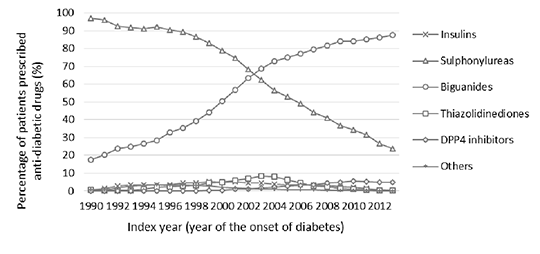Trends in anti-diabetic and other cardiovascular medications in patients with type 2 diabetes mellitus aged 80 years or older: population-based cohort study Background and Objective: Very old people, aged more than 80 years, represent an increasingly important group of health services users. There is limited evidence to inform care of very old people because they have either not been included in clinical trials, or only included in small numbers. Type 2 diabetes mellitus (T2DM) is a growing concern at all ages. Treatment recommendations for older people with T2DM are largely based on professional opinion based on evidence in younger groups. We evaluated trends in utilisation of anti-diabetic and other cardiovascular drugs for T2DM patients aged 80 years or older in the UK. Methods: A population-based cohort was sampled form the UK Clinical Practice Research Datalink (CPRD) between 1990 and 2013. Eligible patients were those with T2DM onset after the age of 80 years old and at least one anti-diabetic drug prescription. Utilisation of anti-diabetic drugs, anti-coagulants, anti-platelets, anti-hypertensive drugs, and lipid-lowering drugs were evaluated by year. Trends by year were evaluated after adjusting for age and sex. Results and Discussion: From 1990 to 2013, the mainstay of anti-diabetic therapy changed from sulphonylureas to biguanides (Fig. 1). Fewer than 10% of patients were prescribed insulin. Patients developing T2DM after 90 years were less likely to be prescribed anti-diabetic drugs except for sulphonylureas. Prescriptions of thiazolidinediones had increased from the market introduction as in younger adults reported before (1), but decreased after the concern about cardiovascular adverse effects was raised. Prescriptions of DPP-4 inhibitors started to rise.
Conclusion: Prescriptions of anti-diabetic and other cardiovascular medications for T2DM patients over 80 years had been markedly changed over time, which were considered to be related to accumulated evidence for drugs, understanding T2DM and its complications, and availability of newly developed drugs. Further research is needed to investigate if these medications contribute to lessen mortality and morbidities in very old population with limited life expectancy. (1) Filion KB et al. (2009). Pharmacoepidemiol Drug Saf 18: 973-976.
|


